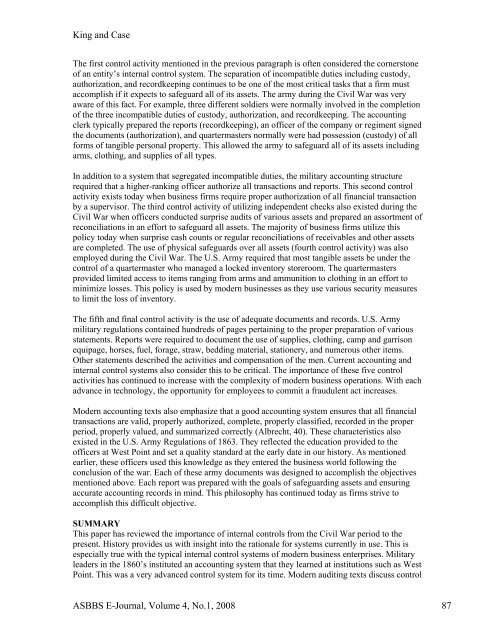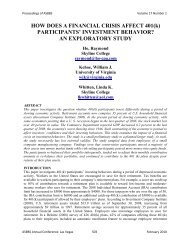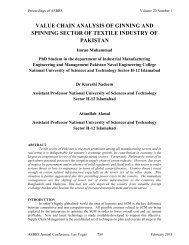stock repurchase announcements: a test of market ... - Asbbs.org
stock repurchase announcements: a test of market ... - Asbbs.org
stock repurchase announcements: a test of market ... - Asbbs.org
Create successful ePaper yourself
Turn your PDF publications into a flip-book with our unique Google optimized e-Paper software.
King and Case<br />
The first control activity mentioned in the previous paragraph is <strong>of</strong>ten considered the cornerstone<br />
<strong>of</strong> an entity’s internal control system. The separation <strong>of</strong> incompatible duties including custody,<br />
authorization, and recordkeeping continues to be one <strong>of</strong> the most critical tasks that a firm must<br />
accomplish if it expects to safeguard all <strong>of</strong> its assets. The army during the Civil War was very<br />
aware <strong>of</strong> this fact. For example, three different soldiers were normally involved in the completion<br />
<strong>of</strong> the three incompatible duties <strong>of</strong> custody, authorization, and recordkeeping. The accounting<br />
clerk typically prepared the reports (recordkeeping), an <strong>of</strong>ficer <strong>of</strong> the company or regiment signed<br />
the documents (authorization), and quartermasters normally were had possession (custody) <strong>of</strong> all<br />
forms <strong>of</strong> tangible personal property. This allowed the army to safeguard all <strong>of</strong> its assets including<br />
arms, clothing, and supplies <strong>of</strong> all types.<br />
In addition to a system that segregated incompatible duties, the military accounting structure<br />
required that a higher-ranking <strong>of</strong>ficer authorize all transactions and reports. This second control<br />
activity exists today when business firms require proper authorization <strong>of</strong> all financial transaction<br />
by a supervisor. The third control activity <strong>of</strong> utilizing independent checks also existed during the<br />
Civil War when <strong>of</strong>ficers conducted surprise audits <strong>of</strong> various assets and prepared an assortment <strong>of</strong><br />
reconciliations in an effort to safeguard all assets. The majority <strong>of</strong> business firms utilize this<br />
policy today when surprise cash counts or regular reconciliations <strong>of</strong> receivables and other assets<br />
are completed. The use <strong>of</strong> physical safeguards over all assets (fourth control activity) was also<br />
employed during the Civil War. The U.S. Army required that most tangible assets be under the<br />
control <strong>of</strong> a quartermaster who managed a locked inventory storeroom. The quartermasters<br />
provided limited access to items ranging from arms and ammunition to clothing in an effort to<br />
minimize losses. This policy is used by modern businesses as they use various security measures<br />
to limit the loss <strong>of</strong> inventory.<br />
The fifth and final control activity is the use <strong>of</strong> adequate documents and records. U.S. Army<br />
military regulations contained hundreds <strong>of</strong> pages pertaining to the proper preparation <strong>of</strong> various<br />
statements. Reports were required to document the use <strong>of</strong> supplies, clothing, camp and garrison<br />
equipage, horses, fuel, forage, straw, bedding material, stationery, and numerous other items.<br />
Other statements described the activities and compensation <strong>of</strong> the men. Current accounting and<br />
internal control systems also consider this to be critical. The importance <strong>of</strong> these five control<br />
activities has continued to increase with the complexity <strong>of</strong> modern business operations. With each<br />
advance in technology, the opportunity for employees to commit a fraudulent act increases.<br />
Modern accounting texts also emphasize that a good accounting system ensures that all financial<br />
transactions are valid, properly authorized, complete, properly classified, recorded in the proper<br />
period, properly valued, and summarized correctly (Albrecht, 40). These characteristics also<br />
existed in the U.S. Army Regulations <strong>of</strong> 1863. They reflected the education provided to the<br />
<strong>of</strong>ficers at West Point and set a quality standard at the early date in our history. As mentioned<br />
earlier, these <strong>of</strong>ficers used this knowledge as they entered the business world following the<br />
conclusion <strong>of</strong> the war. Each <strong>of</strong> these army documents was designed to accomplish the objectives<br />
mentioned above. Each report was prepared with the goals <strong>of</strong> safeguarding assets and ensuring<br />
accurate accounting records in mind. This philosophy has continued today as firms strive to<br />
accomplish this difficult objective.<br />
SUMMARY<br />
This paper has reviewed the importance <strong>of</strong> internal controls from the Civil War period to the<br />
present. History provides us with insight into the rationale for systems currently in use. This is<br />
especially true with the typical internal control systems <strong>of</strong> modern business enterprises. Military<br />
leaders in the 1860’s instituted an accounting system that they learned at institutions such as West<br />
Point. This was a very advanced control system for its time. Modern auditing texts discuss control<br />
ASBBS E-Journal, Volume 4, No.1, 2008 87

















